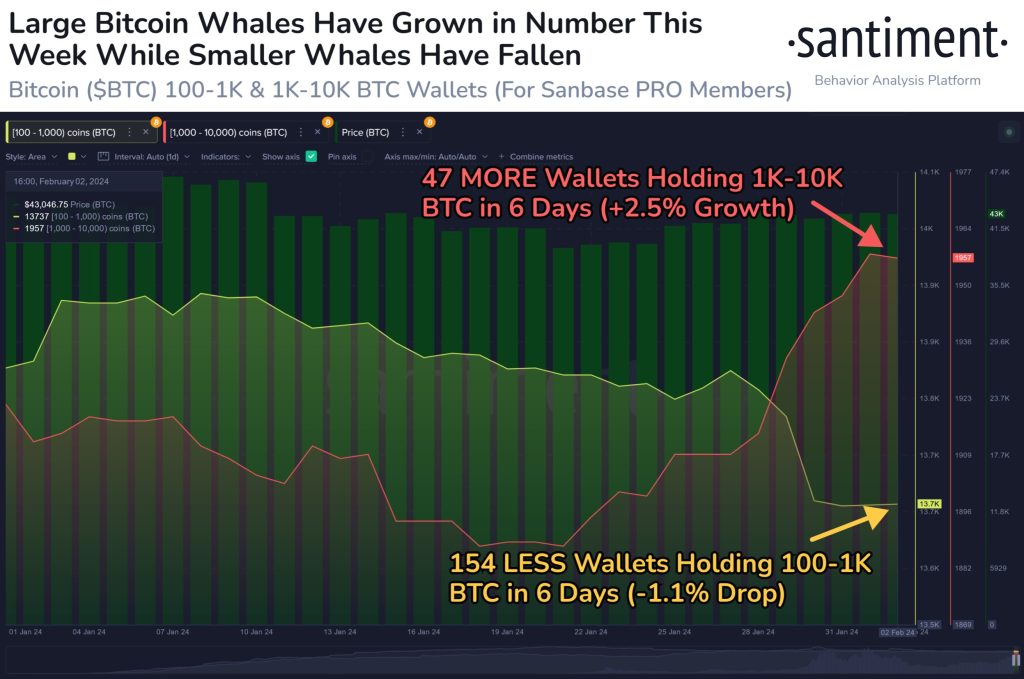China stocks crash 8% in hours — 5 things to know in Bitcoin this week

Bitcoin price circles $43,000 as Chinese stocks are halted for volatility in a wild start to the macro week.

Bitcoin (BTC) begins its first full week of February with an escape from a breakdown below $42,000.
BTC price action remains in a sticky range — one which saw January gains capped at just 0.6%. What might be next for the market?
Still battling the low to mid-$40,000 area, Bitcoin bulls so far lack genuine momentum required to overcome sell pressure and challenge range highs.
The road ahead looks increasingly bumpy: the halving is around two-and-a-half months away, and perspectives on how price will react both before and after differ considerably.
Some believe that major change is incoming and that Bitcoin might not only smash its way through local resistance but even set a new all-time high before mid-April. Other takes call for “business as usual” — no significant price action until months after the halving takes place.
In the background, macroeconomic risks continue to fester, this week joined by fresh turmoil in Chinese equities markets.
With United States data surprising markets last week, there are thus questions over how the Federal Reserve’s economic policy might evolve — especially when it comes to the timing of interest rate cuts, a key issue for crypto and risk assets.
Cointelegraph takes a closer look at these topics and more in the weekly rundown of what to look out for when it comes to BTC/USD.
BTC price indicators forewarn of volatility
At around $42,550 on Bitstamp, Bitcoin’s latest weekly close was its second-highest of 2024.
What followed was familiar behavior — BTC/USD sought to sell off, this time offering two retests of $42,200 before rebounding to around $600 higher at the time of writing, per data from Cointelegraph Markets Pro and TradingView.

Bid liquidity thus preserved the current zone of interest within a wider range that Bitcoin has acted in for more than 150 days.
In his latest spot market analysis, popular trader Skew noted that it was a limit bidder protecting overnight price action from further downside.
$BTC Coinbase Spot
Most of the limit bid that protected the low in the previous tweet has now been filledkey is taker flow on coinbase now & if limit bids support price else likely gets faded later$BTC Spot CVDs & Delta
Most of today’s taker bid & volume is driven by binance… https://t.co/X7eLQQxJdK pic.twitter.com/NNfTeyUpXU— Skew Δ (@52kskew) February 5, 2024
Conjuring memories of mid-January in the aftermath of the comedown from two-year highs above $49,000, he additionally flagged $43,100 as the key level to overcome.
“So what im looking for today is if price continues to hold 1H/4H trend & if buyers sustain a move above $43.1K / diagonal downtrend line,” part of another post on X explained.
An accompanying chart contained features including both simple and exponential moving averages on the 4-hour chart, as well as the sloping resistance line.

Elsewhere, both the Relative Strength Index (RSI) and Bollinger Bands began to give signs that volatility may return.
On weekly timeframes, RSI has reset to lower levels while the spot price has consolidated, as noted by analyst Matthew Hyland at the weekend.
Currently, the weekly RSI stands at 68.9 — just below the key 70 level, which often accompanies major episodes of price upside.
#BTC Weekly RSI has been trending down while price has consolidated: pic.twitter.com/1bBBrsdSGd
— Matthew Hyland (@MatthewHyland_) February 4, 2024
Meanwhile, the three-day Bollinger Bands chart shows a considerable squeeze underway, with the Bands tighter than at any point since the end of October 2023, Hyland reveals.
As Cointelegraph often reports, periods of tighter bands suggest that price expansion is to follow — but it is not immediately clear in which direction.
#BTC 3-Day Bollinger Bands squeezing!
Tightest since pre-30k move break in October: pic.twitter.com/80AkVtVqLm
— Matthew Hyland (@MatthewHyland_) February 4, 2024
A pre-halving Bitcoin all-time high?
A central argument for Bitcoiners this year — as every four years — is the block subsidy halving.
Currently due on April 18, this will cut the amount miners receive as a reward for mining each block by 50% to 3.125 BTC.
While still more than two months away, the impact of the halving on market psychology is already being discussed and closely monitored by commentators. Their ideas of what could end up happening to BTC price action as a result, however, vary wildly.
In a market update on Feb. 2, trading suite DecenTrader CEO and co-founder Filbfilb adopted a tone of resignation.
In his eyes, this halving year will play out like others before it, with no significant price gains until many months after the event. What is expected, however, is for the market to “sell the news” about the halving — just like with the January launch of the first U.S. spot Bitcoin exchange-traded funds (ETFs).
“So in terms of forecast, it seems reasonable to expect some continued choppy consolidation until early March, before some additional fomo towards the $49k level followed by a sell-the-news event again,” Filbfilb wrote.
“Bitcoin has a tendency to front run the sell-the-news with a halving so bear that in mind. Following the Halving, Bitcoin has taken 220 – 240 days to break to new all time highs. I am expecting a similar outlook, with Bitcoin taking a trip to new all time highs in mid to late Q4 of 2024, which give some time for a correction to test investor’s revsolve inbetween.”

As Cointelegraph reported, Q4 2024 is in fact somewhat earlier than many mainstream BTC price prognoses when it comes to new all-time highs.
Filbfilb’s forecast nonetheless provides a major contrast to those from optimistic voices seeking a challenge of BTC price records at or even before the halving.
“Let’s step back and ask ourselves how the next 30 to 60 days could play out. A lot of people are fearing a dip, but I want to lay out the bull scenario,” popular investor Fred Krueger wrote in an X post on Feb. 4.
Krueger based his hypothesis on rapid changes in the new ETFs’ netflows, where selling pressure is consistently decreasing.
“They are at a total of 175K coins, valued at 7.5 Billion. This in 18 trading sessions,” he calculated.
“Over the next 30 to 60 days, there are 20 to 40 trading sessions. I would bet this results in between 4 and 6 Billion new USD in inflows. At a market cap of 850 Billion, it’s pretty easy to see this *could* move the market 50% or to 64K. Basically at all time high.”
Yeah it can be absolutely very violent. And I expect violence.
— Fred Krueger (@dotkrueger) February 4, 2024
James Van Straten, research and data analyst at crypto insights firm CryptoSlate, drew comparisons to recent gains in Meta’s market cap, with Krueger responding that he “expects violence” when it comes to Bitcoin’s own advance.
Spot Bitcoin ETFs scoop up BTC
Those ETF flows in themselves make for impressive reading.
Worldwide, the total BTC supply now contained in ETF products has passed 3%, while among the U.S. spot offerings, asset managers BlackRock and Fidelity own three-quarters of the newly-amassed BTC.
This is excluding the Grayscale Bitcoin Trust (GBTC), the newly-converted ETF which continues to provide considerable outflows as clients withdraw.
The volume race isn’t even close today. $GBTC trouncing peers by over $100 mln. Another day with aggregate dollar volumes below $1 billion though pic.twitter.com/xPCvIZPM3a
— James Seyffart (@JSeyff) February 2, 2024
As noted by both Cointelegraph ETF investment advisor Nate Geraci, the BlackRock and Fidelity offerings nonetheless made the top ten ETFs by inflows last month, despite only launching on Jan. 11.
“Never thought I’d see the day,” he wrote in part of X comments.
Previously, Cointelegraph reported on a game of “wait and see” being played by market observers when it comes to the spot ETFs.
Grayscale pressure is easing, and ultimately, they believe, net outflows should cease.
“Once we start to see green on this chart, what narrative do you have to sell other than some unknown event that we don’t know about now,” financial commentator Tedtalksmacro argued in a recent YouTube video about GBTC outflows.

China vows to step in as stocks halted
Beyond Bitcoin, what was chalked up to be a relatively quiet macroeconomic data week already has the potential to surprise.
This time, it is China at the helm of volatility, as equities hit five-year lows and the CSI 1000 index crashed 8%, halting trading for 30% of its stocks.

The drama follows liquidity injections from Beijing and the bankruptcy of China’s second-largest property giant by sales, Evergrande.
In a statement issued Feb. 4 quoted by Reuters, The China Securities Regulatory Commission, or CSRC, said that it would “steady expectations and confidence, and adamantly ward off abnormal market fluctuations.”
The CSI 1000 year-to-date losses stood at nearly 27% at the time of writing.
“China’s equity markets seem to final be joining their collapsing real estate market,” trading resource The Kobeissi Letter wrote in part of a reaction.
“China’s HY real estate index is down over 85% from its high just 2 years ago. The question becomes: is this crisis contained?”
BREAKING: China’s CSI 1000 index is now down 8% today and 30% in the first month of 2024.
Over the last 10 days, China’s CSI 1000 index is down a massive 21%.
Just minutes ago, China’s government pledged once again to help stabilize markets.
This comes after countless stimulus… pic.twitter.com/qd4NQEfxOd
— The Kobeissi Letter (@KobeissiLetter) February 5, 2024
This set the scene for a highly-anticipated Wall Street open, coming at a time of guessing games over how the U.S. will conduct a pivot in quantitative tightening (QT).
As Cointelegraph reported, bets on the Fed lowering rates at its March meeting decreased after last week’s nonfarm payrolls data vastly beat expectations.
This week will add unemployment figures to the mix.
At the same time, concerns over regional banking sector health persist. When it comes to the impact on Bitcoin and crypto, Arthur Hayes, former CEO of exchange BitMEX, sees an initial capitulation in March, followed by a dramatic BTC price recovery.
His downside BTC price target sits at $30,000.
Whales rebalance in “big” moves
Behind the scenes and despite the rangebound BTC price landscape, whales are being seen to prepare for change.
Related: Bitcoin price gets stablecoin boost as supply jumps 3.5% in one month
In its latest investigations, research firm Santiment noted major shifts in whale population composition over the past week.
The number of wallets holding between 1,000 BTC and 10,000 BTC is now at its highest since November 2022, while 100–1,000 BTC wallets are contrastingly at their lowest since that time. Numbers stood at 1,958 and 13,735 wallets, respectively.
“Bitcoin is ranging between $41K and $44K, but whale wallets are moving big this week,” it summarized.

November 2022 marked a watershed moment as the collapse of exchange FTX upended crypto markets, culminating in Bitcoin hitting $15,600 lows around one month later.
This article does not contain investment advice or recommendations. Every investment and trading move involves risk, and readers should conduct their own research when making a decision.






… [Trackback]
[…] Find More Info here to that Topic: x.superex.com/academys/markets/4158/ […]
… [Trackback]
[…] Info to that Topic: x.superex.com/academys/markets/4158/ […]
… [Trackback]
[…] Find More here to that Topic: x.superex.com/academys/markets/4158/ […]
… [Trackback]
[…] Find More on to that Topic: x.superex.com/academys/markets/4158/ […]
… [Trackback]
[…] Read More Information here to that Topic: x.superex.com/academys/markets/4158/ […]
… [Trackback]
[…] There you can find 91106 additional Info to that Topic: x.superex.com/academys/markets/4158/ […]
… [Trackback]
[…] Read More on that Topic: x.superex.com/academys/markets/4158/ […]
… [Trackback]
[…] Here you will find 68836 additional Information to that Topic: x.superex.com/academys/markets/4158/ […]
… [Trackback]
[…] There you will find 30961 more Information to that Topic: x.superex.com/academys/markets/4158/ […]
… [Trackback]
[…] Read More on that Topic: x.superex.com/academys/markets/4158/ […]
… [Trackback]
[…] Read More to that Topic: x.superex.com/academys/markets/4158/ […]
… [Trackback]
[…] Read More on on that Topic: x.superex.com/academys/markets/4158/ […]
… [Trackback]
[…] Find More here to that Topic: x.superex.com/academys/markets/4158/ […]
… [Trackback]
[…] Find More Info here to that Topic: x.superex.com/academys/markets/4158/ […]
… [Trackback]
[…] Read More on that Topic: x.superex.com/academys/markets/4158/ […]
… [Trackback]
[…] Find More Info here to that Topic: x.superex.com/academys/markets/4158/ […]
… [Trackback]
[…] Information to that Topic: x.superex.com/academys/markets/4158/ […]
… [Trackback]
[…] Information on that Topic: x.superex.com/academys/markets/4158/ […]
… [Trackback]
[…] Here you will find 48961 more Information on that Topic: x.superex.com/academys/markets/4158/ […]
… [Trackback]
[…] Find More here on that Topic: x.superex.com/academys/markets/4158/ […]
… [Trackback]
[…] Find More to that Topic: x.superex.com/academys/markets/4158/ […]
… [Trackback]
[…] There you will find 76038 additional Info on that Topic: x.superex.com/academys/markets/4158/ […]
… [Trackback]
[…] Read More Info here on that Topic: x.superex.com/academys/markets/4158/ […]
… [Trackback]
[…] Read More here on that Topic: x.superex.com/academys/markets/4158/ […]
… [Trackback]
[…] Find More on to that Topic: x.superex.com/academys/markets/4158/ […]
… [Trackback]
[…] Information to that Topic: x.superex.com/academys/markets/4158/ […]
… [Trackback]
[…] There you will find 23472 additional Information to that Topic: x.superex.com/academys/markets/4158/ […]
… [Trackback]
[…] Find More Info here to that Topic: x.superex.com/academys/markets/4158/ […]